2016 NISSAN 370Z COUPE light
[x] Cancel search: lightPage 379 of 428
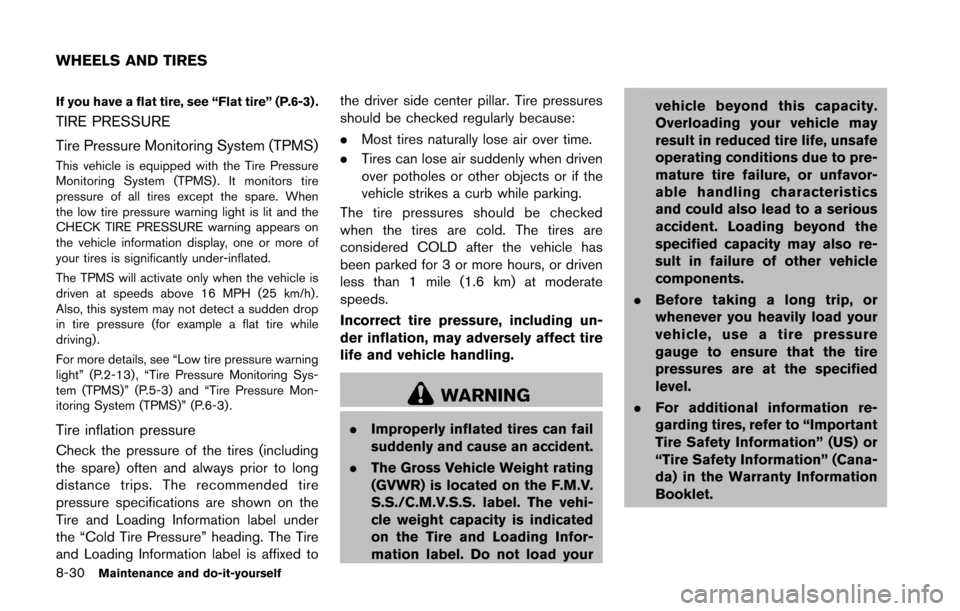
8-30Maintenance and do-it-yourself
If you have a flat tire, see “Flat tire” (P.6-3) .
TIRE PRESSURE
Tire Pressure Monitoring System (TPMS)
This vehicle is equipped with the Tire Pressure
Monitoring System (TPMS) . It monitors tire
pressure of all tires except the spare. When
the low tire pressure warning light is lit and the
CHECK TIRE PRESSURE warning appears on
the vehicle information display, one or more of
your tires is significantly under-inflated.
The TPMS will activate only when the vehicle is
driven at speeds above 16 MPH (25 km/h) .
Also, this system may not detect a sudden drop
in tire pressure (for example a flat tire while
driving) .
For more details, see “Low tire pressure warning
light” (P.2-13) , “Tire Pressure Monitoring Sys-
tem (TPMS)” (P.5-3) and “Tire Pressure Mon-
itoring System (TPMS)” (P.6-3) .
Tire inflation pressure
Check the pressure of the tires (including
the spare) often and always prior to long
distance trips. The recommended tire
pressure specifications are shown on the
Tire and Loading Information label under
the “Cold Tire Pressure” heading. The Tire
and Loading Information label is affixed tothe driver side center pillar. Tire pressures
should be checked regularly because:
.
Most tires naturally lose air over time.
. Tires can lose air suddenly when driven
over potholes or other objects or if the
vehicle strikes a curb while parking.
The tire pressures should be checked
when the tires are cold. The tires are
considered COLD after the vehicle has
been parked for 3 or more hours, or driven
less than 1 mile (1.6 km) at moderate
speeds.
Incorrect tire pressure, including un-
der inflation, may adversely affect tire
life and vehicle handling.
WARNING
. Improperly inflated tires can fail
suddenly and cause an accident.
. The Gross Vehicle Weight rating
(GVWR) is located on the F.M.V.
S.S./C.M.V.S.S. label. The vehi-
cle weight capacity is indicated
on the Tire and Loading Infor-
mation label. Do not load your vehicle beyond this capacity.
Overloading your vehicle may
result in reduced tire life, unsafe
operating conditions due to pre-
mature tire failure, or unfavor-
able handling characteristics
and could also lead to a serious
accident. Loading beyond the
specified capacity may also re-
sult in failure of other vehicle
components.
. Before taking a long trip, or
whenever you heavily load your
vehicle, use a tire pressure
gauge to ensure that the tire
pressures are at the specified
level.
. For additional information re-
garding tires, refer to “Important
Tire Safety Information” (US) or
“Tire Safety Information” (Cana-
da) in the Warranty Information
Booklet.
WHEELS AND TIRES
Page 387 of 428
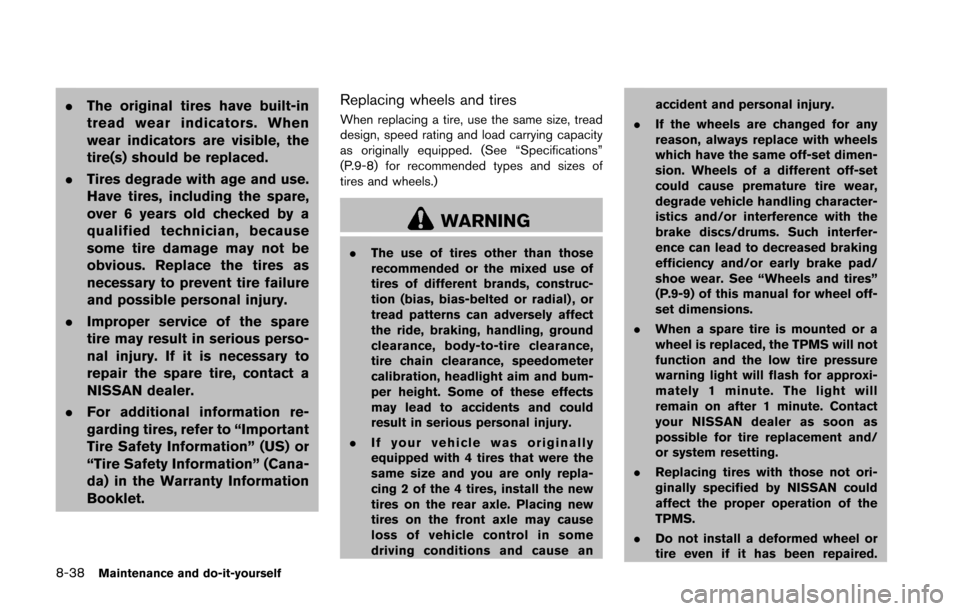
8-38Maintenance and do-it-yourself
.The original tires have built-in
tread wear indicators. When
wear indicators are visible, the
tire(s) should be replaced.
. Tires degrade with age and use.
Have tires, including the spare,
over 6 years old checked by a
qualified technician, because
some tire damage may not be
obvious. Replace the tires as
necessary to prevent tire failure
and possible personal injury.
. Improper service of the spare
tire may result in serious perso-
nal injury. If it is necessary to
repair the spare tire, contact a
NISSAN dealer.
. For additional information re-
garding tires, refer to “Important
Tire Safety Information” (US) or
“Tire Safety Information” (Cana-
da) in the Warranty Information
Booklet.Replacing wheels and tires
When replacing a tire, use the same size, tread
design, speed rating and load carrying capacity
as originally equipped. (See “Specifications”
(P.9-8) for recommended types and sizes of
tires and wheels.)
WARNING
. The use of tires other than those
recommended or the mixed use of
tires of different brands, construc-
tion (bias, bias-belted or radial) , or
tread patterns can adversely affect
the ride, braking, handling, ground
clearance, body-to-tire clearance,
tire chain clearance, speedometer
calibration, headlight aim and bum-
per height. Some of these effects
may lead to accidents and could
result in serious personal injury.
. If your vehicle was originally
equipped with 4 tires that were the
same size and you are only repla-
cing 2 of the 4 tires, install the new
tires on the rear axle. Placing new
tires on the front axle may cause
loss of vehicle control in some
driving conditions and cause an accident and personal injury.
. If the wheels are changed for any
reason, always replace with wheels
which have the same off-set dimen-
sion. Wheels of a different off-set
could cause premature tire wear,
degrade vehicle handling character-
istics and/or interference with the
brake discs/drums. Such interfer-
ence can lead to decreased braking
efficiency and/or early brake pad/
shoe wear. See “Wheels and tires”
(P.9-9) of this manual for wheel off-
set dimensions.
. When a spare tire is mounted or a
wheel is replaced, the TPMS will not
function and the low tire pressure
warning light will flash for approxi-
mately 1 minute. The light will
remain on after 1 minute. Contact
your NISSAN dealer as soon as
possible for tire replacement and/
or system resetting.
. Replacing tires with those not ori-
ginally specified by NISSAN could
affect the proper operation of the
TPMS.
. Do not install a deformed wheel or
tire even if it has been repaired.
Page 389 of 428

8-40Maintenance and do-it-yourself
CAUTION
.Do not use tire chains on a TEM-
PORARY USE ONLY spare tire. Tire
chains will not fit properly and may
cause damage to the vehicle.
. Because the TEMPORARY USE
ONLY spare tire is smaller than the
original tire, ground clearance is
reduced. To avoid damage to the
vehicle, do not drive over obstacles.
Also do not drive the vehicle
through an automatic car wash
since it may get caught.
EMERGENCY TIRE PUNCTURE RE-
PAIR KIT (if so equipped)
The emergency tire puncture repair kit (Emer-
gency Tire Sealant) is supplied with the vehicle
instead of a spare tire. It can be used to
temporarily repair minor tire punctures.
If possible, have the vehicle towed to a facility
that can repair or replace the flat tire. Using the
emergency tire puncture repair kit may cause a
malfunction of the tire pressure sensor and
cause the low tire pressure warning light to
illuminate.
See “Flat tire” (P.6-3) for more details.
Page 396 of 428
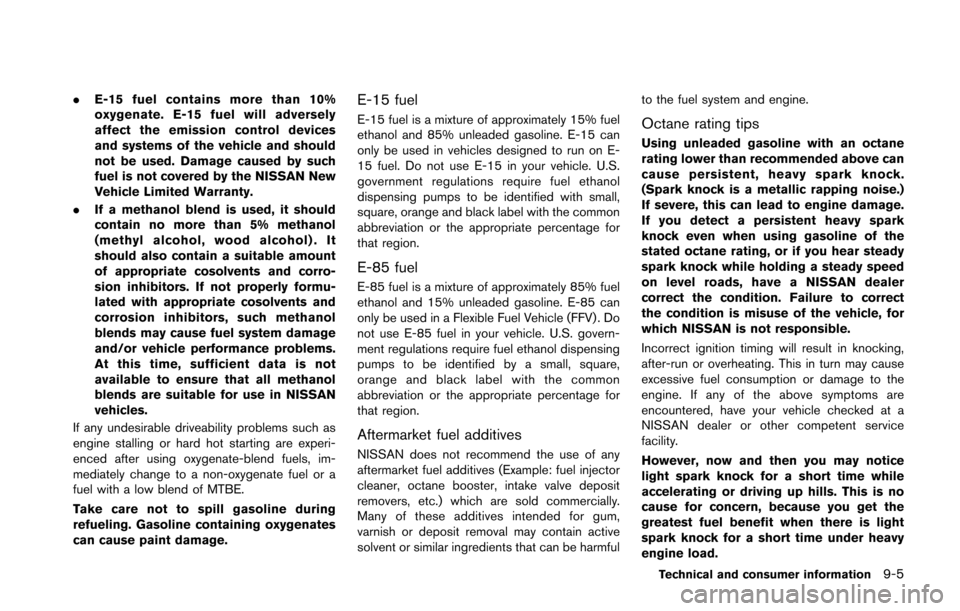
.E-15 fuel contains more than 10%
oxygenate. E-15 fuel will adversely
affect the emission control devices
and systems of the vehicle and should
not be used. Damage caused by such
fuel is not covered by the NISSAN New
Vehicle Limited Warranty.
. If a methanol blend is used, it should
contain no more than 5% methanol
(methyl alcohol, wood alcohol) . It
should also contain a suitable amount
of appropriate cosolvents and corro-
sion inhibitors. If not properly formu-
lated with appropriate cosolvents and
corrosion inhibitors, such methanol
blends may cause fuel system damage
and/or vehicle performance problems.
At this time, sufficient data is not
available to ensure that all methanol
blends are suitable for use in NISSAN
vehicles.
If any undesirable driveability problems such as
engine stalling or hard hot starting are experi-
enced after using oxygenate-blend fuels, im-
mediately change to a non-oxygenate fuel or a
fuel with a low blend of MTBE.
Take care not to spill gasoline during
refueling. Gasoline containing oxygenates
can cause paint damage.E-15 fuel
E-15 fuel is a mixture of approximately 15% fuel
ethanol and 85% unleaded gasoline. E-15 can
only be used in vehicles designed to run on E-
15 fuel. Do not use E-15 in your vehicle. U.S.
government regulations require fuel ethanol
dispensing pumps to be identified with small,
square, orange and black label with the common
abbreviation or the appropriate percentage for
that region.
E-85 fuel
E-85 fuel is a mixture of approximately 85% fuel
ethanol and 15% unleaded gasoline. E-85 can
only be used in a Flexible Fuel Vehicle (FFV) . Do
not use E-85 fuel in your vehicle. U.S. govern-
ment regulations require fuel ethanol dispensing
pumps to be identified by a small, square,
orange and black label with the common
abbreviation or the appropriate percentage for
that region.
Aftermarket fuel additives
NISSAN does not recommend the use of any
aftermarket fuel additives (Example: fuel injector
cleaner, octane booster, intake valve deposit
removers, etc.) which are sold commercially.
Many of these additives intended for gum,
varnish or deposit removal may contain active
solvent or similar ingredients that can be harmful to the fuel system and engine.
Octane rating tips
Using unleaded gasoline with an octane
rating lower than recommended above can
cause persistent, heavy spark knock.
(Spark knock is a metallic rapping noise.)
If severe, this can lead to engine damage.
If you detect a persistent heavy spark
knock even when using gasoline of the
stated octane rating, or if you hear steady
spark knock while holding a steady speed
on level roads, have a NISSAN dealer
correct the condition. Failure to correct
the condition is misuse of the vehicle, for
which NISSAN is not responsible.
Incorrect ignition timing will result in knocking,
after-run or overheating. This in turn may cause
excessive fuel consumption or damage to the
engine. If any of the above symptoms are
encountered, have your vehicle checked at a
NISSAN dealer or other competent service
facility.
However, now and then you may notice
light spark knock for a short time while
accelerating or driving up hills. This is no
cause for concern, because you get the
greatest fuel benefit when there is light
spark knock for a short time under heavy
engine load.
Technical and consumer information9-5
Page 415 of 428
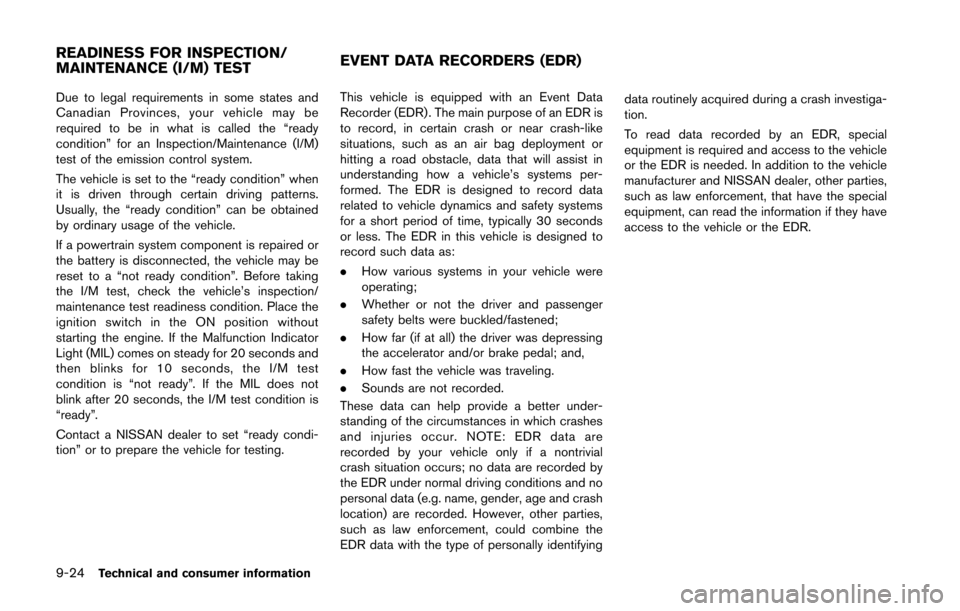
9-24Technical and consumer information
Due to legal requirements in some states and
Canadian Provinces, your vehicle may be
required to be in what is called the “ready
condition” for an Inspection/Maintenance (I/M)
test of the emission control system.
The vehicle is set to the “ready condition” when
it is driven through certain driving patterns.
Usually, the “ready condition” can be obtained
by ordinary usage of the vehicle.
If a powertrain system component is repaired or
the battery is disconnected, the vehicle may be
reset to a “not ready condition”. Before taking
the I/M test, check the vehicle’s inspection/
maintenance test readiness condition. Place the
ignition switch in the ON position without
starting the engine. If the Malfunction Indicator
Light (MIL) comes on steady for 20 seconds and
then blinks for 10 seconds, the I/M test
condition is “not ready”. If the MIL does not
blink after 20 seconds, the I/M test condition is
“ready”.
Contact a NISSAN dealer to set “ready condi-
tion” or to prepare the vehicle for testing.This vehicle is equipped with an Event Data
Recorder (EDR) . The main purpose of an EDR is
to record, in certain crash or near crash-like
situations, such as an air bag deployment or
hitting a road obstacle, data that will assist in
understanding how a vehicle’s systems per-
formed. The EDR is designed to record data
related to vehicle dynamics and safety systems
for a short period of time, typically 30 seconds
or less. The EDR in this vehicle is designed to
record such data as:
.
How various systems in your vehicle were
operating;
. Whether or not the driver and passenger
safety belts were buckled/fastened;
. How far (if at all) the driver was depressing
the accelerator and/or brake pedal; and,
. How fast the vehicle was traveling.
. Sounds are not recorded.
These data can help provide a better under-
standing of the circumstances in which crashes
and injuries occur. NOTE: EDR data are
recorded by your vehicle only if a nontrivial
crash situation occurs; no data are recorded by
the EDR under normal driving conditions and no
personal data (e.g. name, gender, age and crash
location) are recorded. However, other parties,
such as law enforcement, could combine the
EDR data with the type of personally identifying data routinely acquired during a crash investiga-
tion.
To read data recorded by an EDR, special
equipment is required and access to the vehicle
or the EDR is needed. In addition to the vehicle
manufacturer and NISSAN dealer, other parties,
such as law enforcement, that have the special
equipment, can read the information if they have
access to the vehicle or the EDR.
READINESS FOR INSPECTION/
MAINTENANCE (I/M) TEST
EVENT DATA RECORDERS (EDR)
Page 420 of 428
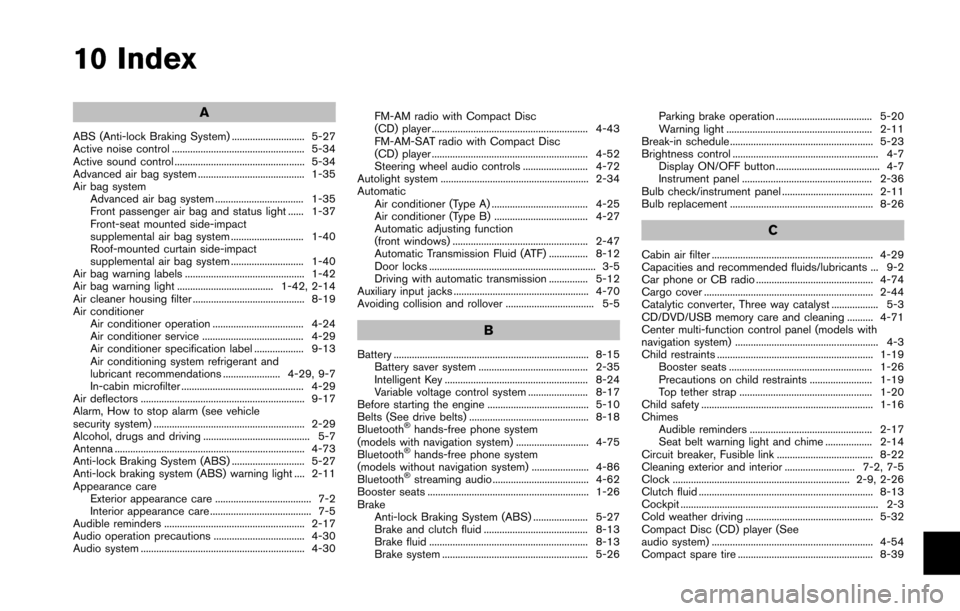
10 Index
A
ABS (Anti-lock Braking System) ............................ 5-27
Active noise control ................................................... 5-34
Active sound control .................................................. 5-34
Advanced air bag system ......................................... 1-35
Air bag systemAdvanced air bag system .................................. 1-35
Front passenger air bag and status light ...... 1-37
Front-seat mounted side-impact
supplemental air bag system ............................ 1-40
Roof-mounted curtain side-impact
supplemental air bag system ............................ 1-40
Air bag warning labels .............................................. 1-42
Air bag warning light ..................................... 1-42, 2-14
Air cleaner housing filter ........................................... 8-19
Air conditioner Air conditioner operation ................................... 4-24
Air conditioner service ....................................... 4-29
Air conditioner specification label ................... 9-13
Air conditioning system refrigerant and
lubricant recommendations ...................... 4-29, 9-7
In-cabin microfilter ............................................... 4-29
Air deflectors ............................................................... 9-17
Alarm, How to stop alarm (see vehicle
security system) .......................................................... 2-29
Alcohol, drugs and driving ......................................... 5-7
Antenna ......................................................................... 4-73
Anti-lock Braking System (ABS) ............................ 5-27
Anti-lock braking system (ABS) warning light .... 2-11
Appearance care Exterior appearance care ..................................... 7-2
Interior appearance care ....................................... 7-5
Audible reminders ...................................................... 2-17
Audio operation precautions ................................... 4-30
Audio system ............................................................... 4-30 FM-AM radio with Compact Disc
(CD) player ............................................................ 4-43
FM-AM-SAT radio with Compact Disc
(CD) player ............................................................ 4-52
Steering wheel audio controls ......................... 4-72
Autolight system ......................................................... 2-34
Automatic Air conditioner (Type A) ..................................... 4-25
Air conditioner (Type B) .................................... 4-27
Automatic adjusting function
(front windows) .................................................... 2-47
Automatic Transmission Fluid (ATF) ............... 8-12
Door locks ................................................................ 3-5
Driving with automatic transmission ............... 5-12
Auxiliary input jacks .................................................... 4-70
Avoiding collision and rollover .................................. 5-5
B
Battery ........................................................................... 8-15 Battery saver system .......................................... 2-35
Intelligent Key ....................................................... 8-24
Variable voltage control system ....................... 8-17
Before starting the engine ....................................... 5-10
Belts (See drive belts) .............................................. 8-18
Bluetooth
�Šhands-free phone system
(models with navigation system) ............................ 4-75
Bluetooth
�Šhands-free phone system
(models without navigation system) ...................... 4-86
Bluetooth
�Šstreaming audio ..................................... 4-62
Booster seats .............................................................. 1-26
Brake Anti-lock Braking System (ABS) ..................... 5-27
Brake and clutch fluid ........................................ 8-13
Brake fluid ............................................................. 8-13
Brake system ........................................................ 5-26 Parking brake operation ..................................... 5-20
Warning light ........................................................ 2-11
Break-in schedule ....................................................... 5-23
Brightness control ........................................................ 4-7 Display ON/OFF button ........................................ 4-7
Instrument panel .................................................. 2-36
Bulb check/instrument panel ................................... 2-11
Bulb replacement ....................................................... 8-26
C
Cabin air filter .............................................................. 4-29
Capacities and recommended fluids/lubricants ... 9-2
Car phone or CB radio ............................................. 4-74
Cargo cover ................................................................. 2-44
Catalytic converter, Three way catalyst .................. 5-3
CD/DVD/USB memory care and cleaning .......... 4-71
Center multi-function control panel (models with
navigation system) ....................................................... 4-3
Child restraints ............................................................ 1-19 Booster seats ....................................................... 1-26
Precautions on child restraints ........................ 1-19
Top tether strap ................................................... 1-20
Child safety .................................................................. 1-16
Chimes Audible reminders ............................................... 2-17
Seat belt warning light and chime .................. 2-14
Circuit breaker, Fusible link ..................................... 8-22
Cleaning exterior and interior ........................... 7-2, 7-5
Clock .................................................................... 2-9, 2-26
Clutch fluid ................................................................... 8-13
Cockpit ............................................................................ 2-3
Cold weather driving ................................................. 5-32
Compact Disc (CD) player (See
audio system) .............................................................. 4-54
Compact spare tire .................................................... 8-39
Page 421 of 428
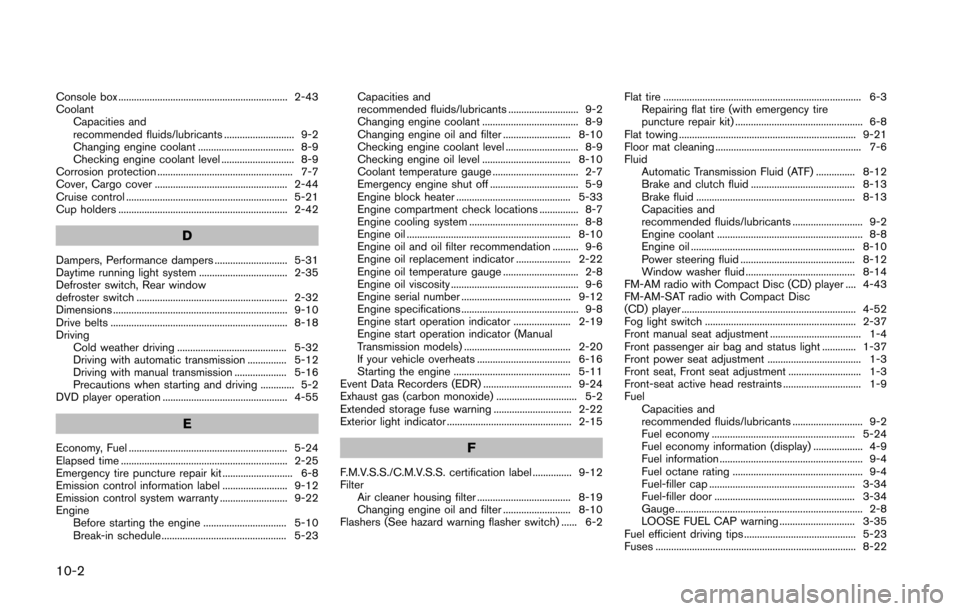
10-2
Console box ................................................................. 2-43
CoolantCapacities and
recommended fluids/lubricants ........................... 9-2
Changing engine coolant ..................................... 8-9
Checking engine coolant level ............................ 8-9
Corrosion protection .................................................... 7-7
Cover, Cargo cover ................................................... 2-44
Cruise control .............................................................. 5-21
Cup holders ................................................................. 2-42
D
Dampers, Performance dampers ............................ 5-31
Daytime running light system .................................. 2-35
Defroster switch, Rear window
defroster switch .......................................................... 2-32
Dimensions ................................................................... 9-10
Drive belts .................................................................... 8-18
Driving Cold weather driving .......................................... 5-32
Driving with automatic transmission ............... 5-12
Driving with manual transmission .................... 5-16
Precautions when starting and driving ............. 5-2
DVD player operation ................................................ 4-55
E
Economy, Fuel ............................................................. 5-24
Elapsed time ................................................................ 2-25
Emergency tire puncture repair kit ........................... 6-8
Emission control information label ......................... 9-12
Emission control system warranty .......................... 9-22
Engine Before starting the engine ................................ 5-10
Break-in schedule ................................................ 5-23 Capacities and
recommended fluids/lubricants ........................... 9-2
Changing engine coolant ..................................... 8-9
Changing engine oil and filter .......................... 8-10
Checking engine coolant level ............................ 8-9
Checking engine oil level .................................. 8-10
Coolant temperature gauge ................................. 2-7
Emergency engine shut off .................................. 5-9
Engine block heater ............................................ 5-33
Engine compartment check locations ............... 8-7
Engine cooling system .......................................... 8-8
Engine oil ............................................................... 8-10
Engine oil and oil filter recommendation .......... 9-6
Engine oil replacement indicator ..................... 2-22
Engine oil temperature gauge ............................. 2-8
Engine oil viscosity ................................................. 9-6
Engine serial number .......................................... 9-12
Engine specifications ............................................. 9-8
Engine start operation indicator ...................... 2-19
Engine start operation indicator (Manual
Transmission models) ......................................... 2-20
If your vehicle overheats .................................... 6-16
Starting the engine ............................................. 5-11
Event Data Recorders (EDR) .................................. 9-24
Exhaust gas (carbon monoxide) ............................... 5-2
Extended storage fuse warning .............................. 2-22
Exterior light indicator ................................................ 2-15F
F.M.V.S.S./C.M.V.S.S. certification label ............... 9-12
Filter Air cleaner housing filter .................................... 8-19
Changing engine oil and filter .......................... 8-10
Flashers (See hazard warning flasher switch) ...... 6-2 Flat tire ............................................................................ 6-3
Repairing flat tire (with emergency tire
puncture repair kit) ................................................. 6-8
Flat towing .................................................................... 9-21
Floor mat cleaning ........................................................ 7-6
Fluid Automatic Transmission Fluid (ATF) ............... 8-12
Brake and clutch fluid ........................................ 8-13
Brake fluid ............................................................. 8-13
Capacities and
recommended fluids/lubricants ........................... 9-2
Engine coolant ........................................................ 8-8
Engine oil ............................................................... 8-10
Power steering fluid ............................................ 8-12
Window washer fluid .......................................... 8-14
FM-AM radio with Compact Disc (CD) player .... 4-43
FM-AM-SAT radio with Compact Disc
(CD) player ................................................................... 4-52
Fog light switch .......................................................... 2-37
Front manual seat adjustment ................................... 1-4
Front passenger air bag and status light ............. 1-37
Front power seat adjustment .................................... 1-3
Front seat, Front seat adjustment ............................ 1-3
Front-seat active head restraints .............................. 1-9
Fuel Capacities and
recommended fluids/lubricants ........................... 9-2
Fuel economy ....................................................... 5-24
Fuel economy information (display) ................... 4-9
Fuel information ....................................................... 9-4
Fuel octane rating .................................................. 9-4
Fuel-filler cap ........................................................ 3-34
Fuel-filler door ...................................................... 3-34
Gauge ........................................................................ 2-8
LOOSE FUEL CAP warning ............................. 3-35
Fuel efficient driving tips ........................................... 5-23
Fuses ............................................................................. 8-22
Page 422 of 428
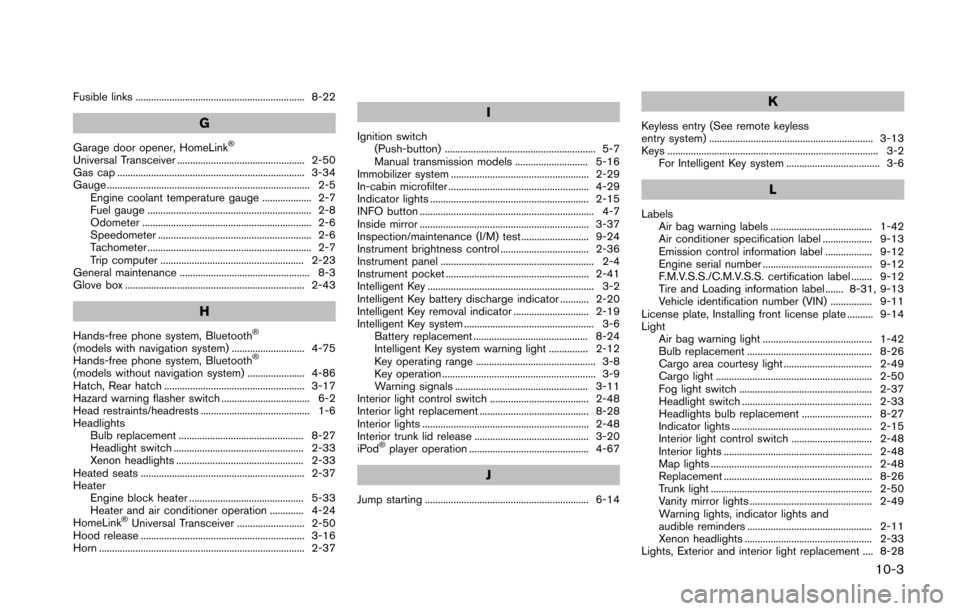
Fusible links ................................................................. 8-22
G
Garage door opener, HomeLink�Š
Universal Transceiver ................................................. 2-50
Gas cap ........................................................................ 3-34
Gauge .............................................................................. 2-5Engine coolant temperature gauge ................... 2-7
Fuel gauge ............................................................... 2-8
Odometer ................................................................. 2-6
Speedometer ........................................................... 2-6
Tachometer ............................................................... 2-7
Trip computer ....................................................... 2-23
General maintenance .................................................. 8-3
Glove box ..................................................................... 2-43
H
Hands-free phone system, Bluetooth�Š
(models with navigation system) ............................ 4-75
Hands-free phone system, Bluetooth�Š
(models without navigation system) ...................... 4-86
Hatch, Rear hatch ...................................................... 3-17
Hazard warning flasher switch .................................. 6-2
Head restraints/headrests .......................................... 1-6
Headlights Bulb replacement ................................................ 8-27
Headlight switch .................................................. 2-33
Xenon headlights ................................................. 2-33
Heated seats ............................................................... 2-37
Heater Engine block heater ............................................ 5-33
Heater and air conditioner operation ............. 4-24
HomeLink
�ŠUniversal Transceiver .......................... 2-50
Hood release ............................................................... 3-16
Horn ............................................................................... 2-37
I
Ignition switch (Push-button) .......................................................... 5-7
Manual transmission models ............................ 5-16
Immobilizer system ..................................................... 2-29
In-cabin microfilter ...................................................... 4-29
Indicator lights ............................................................. 2-15
INFO button ................................................................... 4-7
Inside mirror ................................................................. 3-37
Inspection/maintenance (I/M) test .......................... 9-24
Instrument brightness control .................................. 2-36
Instrument panel ........................................................... 2-4
Instrument pocket ....................................................... 2-41
Intelligent Key ................................................................ 3-2
Intelligent Key battery discharge indicator ........... 2-20
Intelligent Key removal indicator ............................. 2-19
Intelligent Key system .................................................. 3-6 Battery replacement ............................................ 8-24
Intelligent Key system warning light ............... 2-12
Key operating range .............................................. 3-8
Key operation ........................................................... 3-9
Warning signals ................................................... 3-11
Interior light control switch ...................................... 2-48
Interior light replacement .......................................... 8-28
Interior lights ................................................................ 2-48
Interior trunk lid release ............................................ 3-20
iPod
�Šplayer operation .............................................. 4-67
J
Jump starting ............................................................... 6-14
K
Keyless entry (See remote keyless
entry system) ............................................................... 3-13
Keys ................................................................................. 3-2 For Intelligent Key system .................................... 3-6
L
LabelsAir bag warning labels ....................................... 1-42
Air conditioner specification label ................... 9-13
Emission control information label .................. 9-12
Engine serial number .......................................... 9-12
F.M.V.S.S./C.M.V.S.S. certification label ........ 9-12
Tire and Loading information label ....... 8-31, 9-13
Vehicle identification number (VIN) ................ 9-11
License plate, Installing front license plate .......... 9-14
Light Air bag warning light .......................................... 1-42
Bulb replacement ................................................ 8-26
Cargo area courtesy light .................................. 2-49
Cargo light ............................................................ 2-50
Fog light switch ................................................... 2-37
Headlight switch .................................................. 2-33
Headlights bulb replacement ........................... 8-27
Indicator lights ...................................................... 2-15
Interior light control switch ............................... 2-48
Interior lights ......................................................... 2-48
Map lights .............................................................. 2-48
Replacement ......................................................... 8-26
Trunk light .............................................................. 2-50
Vanity mirror lights ............................................... 2-49
Warning lights, indicator lights and
audible reminders ................................................ 2-11
Xenon headlights ................................................. 2-33
Lights, Exterior and interior light replacement .... 8-28
10-3